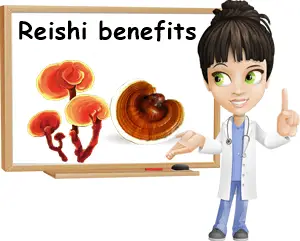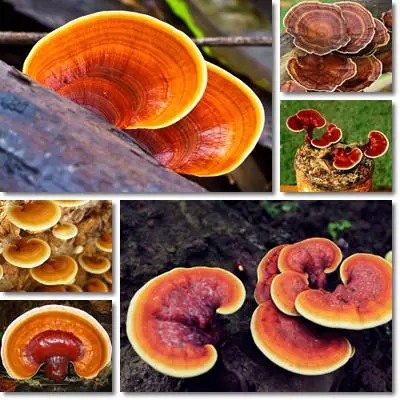Reishi or lingzhi (Ganoderma lucidum) is a variety of edible mushroom with scientifically proven therapeutic properties and a range of medicinal applications. Reishi mushrooms have been used in the traditional Chinese medicinal system for thousands of years. Today, extracts of the mushroom are taken as nutritional supplements and purported to hold a variety of benefits. According to studies, the mushroom holds important immune system-boosting, anti-tumor, anti-diabetic and blood pressure-lowering properties and is being considered for use in immunotherapies aimed at the treatment of cancer and other conditions that could benefit from the enhancement of the immune system response.
What is reishi – Ganoderma lucidum? Reishi is one of the common names for the species of edible and medicinal mushroom scientifically known as Ganoderma lucidum. The term ‘reishi’ is a Japanese loanword, meaning it’s taken or borrowed directly from Japanese and it means ‘spirituality’. Another common name for the species is lingzhi, a Chinese loanword that means ‘divine fungus’ or ‘divine mushroom’. Other names for the species, such as the mushroom of immortality or the ten-thousand-year mushroom are suggestive of the medicinal properties of the species and the belief it can prolong life. Reishi can be found in the wild and grows on maple, oak, elm, beech and other hardwood trees. However, the species is not commonly harvested from the wild where its presence is scarce, so commercial production accounts for most of the mushroom presence on the market.

What do reishi mushrooms look like? In Ganoderma lucidum specimens, the cap is usually uneven, slightly flattened, kidney-shaped or fan-shaped or even somewhat reminiscent of a clam or cockle shell. The foot, if present, is positioned laterally. The color of the cap ranges from a deep red to a orangey or reddish brown to dark brown and comes in a gradient pattern. That is to say reishi caps are darker towards the foot and gradually lighten to a pale yellow or white. The lighter portion of the mushroom cap is referred to as a ‘new growth’. In young mushrooms, the colorful cap has a glossy appearance, but the color tends to become duller with age.
The underside is whitish in young mushrooms and brown in older ones. Because there are no gills, the brown spores are released through pores. If present, the foot or stem either has a gradient color pattern, similar to the cap, or is an even reddish-brown color. In some specimens of Ganoderma lucidum, the cap doesn’t develop at all, leaving just the foot or stem. These specimens are called antler-reishi or lingzhi because of the lack of cap and overall appearance of the mushroom.
What do reishi mushrooms taste like? Reishi are not as palatable as portobellos, crimini, honey fungus or oyster mushrooms. In fact, they taste bitter which does not make them a popular option if not for their medicinal properties and associated health benefits. The bitter, earthy taste of reishi, owed to their alkaloid and triterpenes content, and their tougher flesh do not recommend them for consumption as food, although they are edible. However, the younger specimens better lend themselves to consumption if they are finely sliced before being cooked, provided of course you find the taste even remotely agreeable to begin with.
How to use reishi mushrooms
Because of their lack of palatability, the mushrooms are usually dried and turned into powder which is then consumed in small amounts as a nutritional supplement. There are also nutritional supplements (pills, tablets or capsules) or various food products infused with the mushroom powder. For example, reishi coffee which is basically coffee that contains varying amounts of mushroom powder (usually instant coffee). Another example is reishi tea – essentially dried and finely ground tea herbs with dried, ground reishi. The mushroom powder can be added to water and boiled to make a reishi soup; alternatively, the fresh or dried mushrooms are boiled to make soup.

What does reishi do for health?
The mushroom is primarily consumed for its therapeutic properties and associated health benefits. However, what the reishi mushroom actually does for one’s health is not easily quantifiable and does not always translated into visible, irrefutable health benefits. It’s worth reiterating the fact that the mushroom and its byproducts do not constitute treatment for any medical condition. At most, reishi may play the role of an adjuvant that merely contributes to improving certain aspects of health, in some medical situations, usually when also paired with conventional treatments.
Water and alcohol extracts are believed to harness most of the properties of the mushroom. Actually, reishi extracts are presumed to produce better therapeutic results than pills or tablets containing the dried and ground mushroom or the fresh mushrooms consumed as they are. This is also one reason for the popularity of products such as reishi coffee or reishi tea which allow for the extraction of the main bioactive compounds in the hot coffee or tea water.
The health benefits of reishi mushrooms are a result of several biologically active compounds, notably polysaccharides such as beta-D-glucan, triterpenes such as ganoderic acids (example: ganoderic acid A, ganoderic acid B), ganodermanontriol, but also sterols (ganoderols, ganoderenic acids, ganoderiols, lucidadiol, ganodermadiol or ganoderol B).
What are the benefits?
There is an almost endless list of uses for Ganoderma lucidum, including treating herpes lesions (cold sores), promoting a faster recovery after the flu or improving asthma symptoms or symptoms of urinary tract infections. However, the species does not have as wide a range of action as it’s purported to, not to mention the benefits it does exhibit may vary from person to person, according to existing conditions, current medication plans, dosage and other factors. Find out below what in vitro, animal and clinical studies have found are the potential health benefits, properties and therapeutic uses of reishi mushrooms:
1) Immune system boosting action: studies show the bioactive beta-glucan and other polysaccharides in Ganoderma lucidum enhance the immune system response by increasing the production of NK cells and lymphocytes as well as enhancing NK and lymphocyte activity.
2) Tumor suppression properties: there are studies that show Ganoderma lucidum extracts have the ability to suppress tumor growth in cancer patients (when paired with conventional treatment therapies), which can lead to better quality of life and possibly also increased longevity. One way they do this is by suppressing angiogenesis (the formation of new blood vessels), a vital process for tumor growth.
3) Anti-metastatic potential. As a result of its ability to increase the numbers and enhance the function of lymphocytes and NK cells, reishi may hold anti-metastatic properties and help prevent cancer spread. However, such effects have yet to be replicated in in vivo studies.
4) Blood pressure-lowering and anti-thrombotic properties. Ganoderic acids in the Ganoderma lucidum are believed to play a part in lowering blood pressure numbers, but research is scarce. The blood-thinning properties of the mushrooms may also contribute towards this effect.
5) Cholesterol-lowering properties. By inhibiting cholesterol uptake from food sources and increasing cholesterol elimination with bowel movements, compounds in Ganoderma lucidum may help achieve lower LDL cholesterol and triglyceride levels. One study has found a slight increase in HDL (good) cholesterol levels. However, such effects were mostly observed in in vitro and animal studies.
6) Hepatoprotective activity. The biologically active polysaccharides and triterpenes in the Ganoderma lucidum have been shown to hold hepato-protective benefits. A study published in the International Journal of Medicinal Mushrooms shows the species exerts anti-hepatitis B properties. Another animal study showed acceleration of wound healing on the liver from an immunomodulatory protein known as Ling Zhi-8.
7) Anti-diabetic properties. Biologically active sugar molecules or polysaccharides in Ganoderma lucidum have been found to lower blood sugar (or glucose) levels and even increase the production of the hormone insulin. Animal studies show ganoderan A, B and C to have blood sugar-lowering effects in both healthy and hyperglycemic mice. Certain compounds in the species affect carbohydrate metabolism which may further add to its anti-diabetic properties.
8) Low risks of heavy metal contamination. Because Ganoderma lucidum is rare in the wild, most of the commercial production comes from mushroom farms. This has the benefit of reducing heavy metal contamination, resulting in a cleaner food product with fewer side effects.
What are the side effects?
1) Gastrointestinal side effects. Consumption of reishi can be a source of stomach upset, nausea, loose stools and diarrhea or constipation. Discontinuing consumption is advised. Longer supplementation periods (4-16 weeks, 2-4 months or years) are more likely associated with side effects.
2) Other side effects. Dizziness, headaches, dry mouth, dry throat, dry nose, nosebleeds, itchy skin and a rash may also occur as a result of consumption of the mushroom in its various forms.
3) Potential for allergic reactions. Like all foods, reishi too has the potential to be a food allergen and cause allergic reactions. However, this is rare and the severity of allergy-like symptoms usually stops at itchy skin rashes and loose stools and diarrhea.
4) Liver injury. Reishi mushrooms dangers include hepatotoxic effects. Even though biologically active elements in the mushroom have been found to protect the liver, there are also elements that induce toxicity and can damage the liver, although extremely few cases have been reported.
5) Interactions with medication. Compounds in reishi may interact with anticoagulant and blood-thinning medication, either potentiating their effects or reducing them. Interactions with anti-inflammatory, blood pressure and other medication are also possible.
